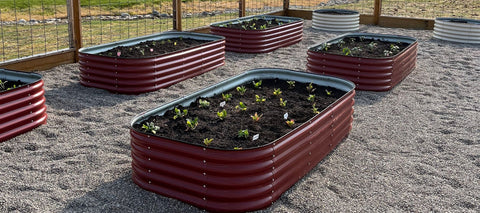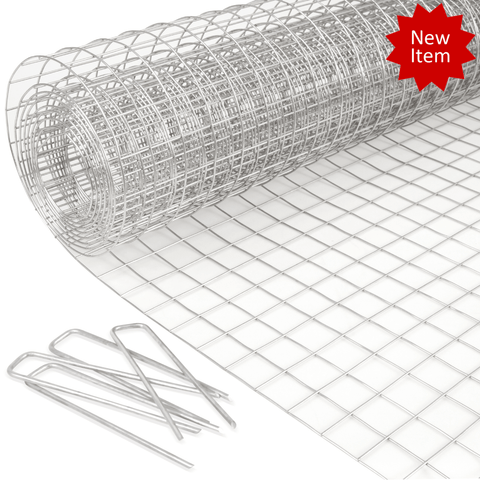Tips from Olle Garden beds:Tackle Pests, Diseases, and Soil Quality with Gopher Netting
A thriving garden is a source of immense joy and satisfaction for any gardener. However, the path to gardening success is often fraught with challenges such as pesky pests, stubborn diseases, and poor soil quality. In this article, we'll explore some common garden problems and discuss a practical solution: gopher netting. Whether you're an experienced gardener or a novice, understanding how to combat these issues can help you achieve a flourishing garden.
Common Garden Problems
Pests: The Bane of Your Garden
Pests come in various forms, from insects like aphids, beetles, and caterpillars to larger critters such as rabbits, squirrels, and gophers. These unwelcome guests can wreak havoc on your plants, eating leaves, stems, and roots. Pesticides are often used to combat pests, but they can harm beneficial insects and have adverse effects on the environment. A more sustainable solution is needed.
Diseases: The Silent Killers
Garden diseases, caused by bacteria, fungi, or viruses, can quickly devastate your plants. Common examples include powdery mildew, blight, and rust. Prevention is key when it comes to garden diseases, as they can be challenging to treat once established.
Soil Quality: The Foundation of Your Garden
Healthy soil is the backbone of any successful garden. Poor soil quality can lead to stunted plant growth, reduced yields, and increased susceptibility to pests and diseases. Common soil issues include compaction, low fertility, and imbalanced pH levels.

Gopher Netting: A Versatile Solution
Gopher netting is a multipurpose tool that effectively addresses all these common garden problems. Here's how it can help:
Pest Control: Keeping Critters at Bay
Gopher netting serves as a physical barrier, preventing larger pests like gophers, rabbits, and squirrels from accessing your garden. By installing the netting around your garden beds or creating underground barriers, you can safeguard your plants without resorting to harmful pesticides.
Disease Prevention: Protecting Your Plants
Some garden diseases are soil-borne or spread through splashing water droplets. Gopher netting can be used as a ground cover or placed over vulnerable plants to prevent soil-borne diseases and reduce the risk of fungal spores splashing onto leaves.
Soil Improvement: A Healthy Foundation
Gopher netting can also be used to enhance soil quality. When placed on the ground, it can act as a weed barrier, reducing weed competition and allowing your plants to thrive. Moreover, it can help retain moisture and protect the soil from erosion, promoting a healthier growing environment.
How to Use Gopher Netting Effectively
Here are some tips for using gopher netting to troubleshoot common garden problems:
Choose the Right Type: Gopher netting comes in various sizes and materials. Select a mesh size appropriate for the pests you want to deter and ensure it's made of durable materials to withstand the elements.
Proper Installation: Install the netting correctly to create an effective barrier. For underground barriers, dig a trench and bury the netting at least 12 inches deep. For above-ground use, secure the netting around your garden beds or individual plants.
Regular Maintenance: Check your gopher netting regularly for wear and tear, and repair or replace it as needed. Ensure it remains secure to keep pests out and protect your plants.
Combine with Other Practices: While gopher netting is an excellent tool, it's most effective when used in conjunction with other gardening best practices, such as crop rotation, proper watering, and soil testing.

Exploring the Many Uses of Gopher Netting with Raised Beds
Gophers can wreak havoc on your garden, munching on roots and causing damage that can be disheartening for any gardening enthusiast. One effective way to deter these underground invaders is by using gopher netting in combination with raised beds. In this part, we'll explore various ways to use gopher netting to safeguard your raised bed garden and keep it thriving.
- Lining the Bottom of Your Raised Bed
One of the most common ways to use gopher netting with a raised bed is by lining the bottom of the bed with it. Simply measure the dimensions of your raised bed and cut the netting to fit. Place it at the bottom before adding soil. This method acts as a barrier, preventing gophers from burrowing up into your raised bed from below.
- Wrapping the Sides of the Raised Bed
Gophers are known for their digging skills, and they can tunnel their way into a raised bed from the sides. To prevent this, consider wrapping gopher netting around the exterior of your raised bed. This added layer of protection makes it difficult for gophers to access your precious plants.
- Creating Gopher-Proof Raised Bed Lids
If you want to go the extra mile in protecting your garden from gophers, consider crafting gopher-proof lids for your raised beds. These lids can be made from wooden frames covered in gopher netting. They are particularly useful for raised beds that house plants susceptible to gopher damage, such as root vegetables.
- Combining Gopher Netting with Raised Bed Fencing
To create a comprehensive gopher deterrent system, combine gopher netting with raised bed fencing. Install a fence around your raised beds, burying the netting a few inches into the ground to prevent gophers from burrowing underneath. This double-layered defense system provides extra protection against gophers and other burrowing pests.

- Using Gopher Netting for Container Gardening
While raised beds are a popular choice for many gardeners, container gardening is also gaining popularity. If you prefer growing your plants in containers, consider placing gopher netting at the bottom of your large pots or containers. This prevents gophers from accessing the plant's roots and causing damage.
- Deterrent for Above-Ground Plants
Gophers aren't limited to underground mischief. They may also feed on the above-ground parts of your plants, particularly during the growing season. In such cases, you can create small gopher netting enclosures or cages around individual plants or rows to keep them safe from nibbling gophers.
- Companion Planting with Gopher-Repellent Plants
Incorporating gopher-repellent plants into your raised bed garden can complement the use of gopher netting. Some plants, like castor beans or gopher spurge, have natural deterrent properties. Planting these alongside your vulnerable crops can help deter gophers from venturing into your garden.
Although it has its rewards, gardening is not without its difficulties. Pests, diseases, and poor soil quality can threaten the health of your garden. However, with the versatile solution of gopher netting, you can tackle these common garden problems effectively and sustainably. By implementing gopher netting in your gardening toolkit, you'll be well on your way to enjoying a thriving and bountiful garden for years to come. Happy gardening!
